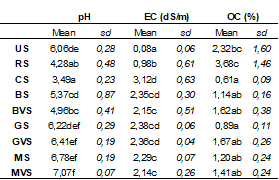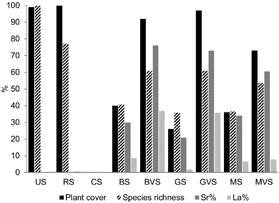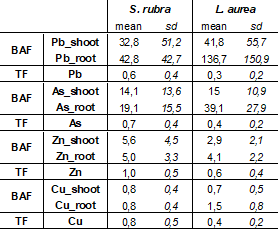INTRODUCTION
Soil pollution by heavy metals is a worldwide problem which poses a risk to ecological systems and to human health and food production. Anthropogenic activities, such as mining, represent important potential sources of soil pollution (Dermont et al., 2008; Liu et al., 2018). One of the most important mining accidents worldwide associated with metal mining spill occurred in Aznalcóllar (SW Spain) on 25 April 1998, when the tailing dam collapsed and around 4,5 x 106 m3 of acidic waters and toxic tailings were spilled into the Agrio and Guadiamar river basins, affecting an area of over 43 km2 (Simón et al., 1999).
A great variety of soil remediation techniques, both in-situ and ex-situ, have been developed and tested in contaminated soils with the aim of reducing the polluting effects (Liu et al., 2018). These techniques may be based on the addition of organic and inorganic amendments to assist the natural remediation processes of soils damaged or contaminated by pollutants (Adriano et al., 2004).
Plants, as an element of the ecosystem, play a significant role in the restoration of degraded or polluted areas, and may act as an indicator of the degree of contamination present in soils. They can accumulate trace elements, especially heavy metals, in or on their tissues, and have a great ability to adapt to variable degrees of pollution present in the environment (Kabata-Pendias, 2000). Also, passive restoration by native vegetation that spontaneously colonize a contaminated area, in improving conditions, is an important factor to consider when evaluating the success of remediation actions (Álvarez-Rogel et al., 2021), as they may act as nurse plants and thus facilitate the growth of less stress-tolerant species (Navarro-Cano et al., 2018).
The present study aims to evaluate the effectiveness of remediation treatments applied to residual polluted soils affected by the Aznalcóllar mining spill by analyzing their influence on the main soil properties, as well as in the spontaneous vegetation recovery.
MATERIAL AND METHODS
The study site corresponds to the area affected by the toxic spill of the Aznalcóllar mine (SW Spain). The area nearby the tailing dam where the spill occurred is characterised by the existence of numerous randomly distributed unvegetated patches. For this study, three unvegetated patches of soils which remained affected by residual pollution were selected. In each of them, an experimental plot of 24 m2 was stablished, subdivided into 6 subplots where six different treatments were applied. The treatments consisted of: BS: Biopile, which consisted of a mixture of contaminated soil affected by the spill with the adjacent recovered soil in a proportion of 50% (w/w); BVS: Biopile + vermicompost; GS: Gypsum mining spoil; GVS: Gypsum mining spoil + vermicompost; MS: Marble sludge; MVS: Marble sludge + vermicompost.
Eigtheen months after the application of the treatments, composite samples of the topsoil (0 - 10 cm) for each of the treatments were taken, and the main soil properties were analized. Also, the vegetation present in the plots was monitored, by measuring the vegetation cover and the plant species richness on every treatment applied. For this purpose, a 0.25 m2 grid divided into 100 cells was used, and the number of cells occupied by herbaceous species, both as total cover and as cover per species, as well as the total number of different species present on the grid, were counted. This was replicated three times per experimental plot and treatment. Finally, vegetation samples of the most frequent plant species were collected to analize the pollutant elements uptake by these colonizing species. Bioaccumulation factor (BAF), both for aerial part and for roots, was calculated to determine the plant´s capacity to take up metal from the soil and to either transport it to the aboveground parts or to accumulate it in the roots. To do so, the different parts of the plant samples were digested in a microwave XP1500Plus (Mars®) in HNO3: H2O2 (1:1), and concentrations of potential pollutants (Pb, As, Zn, Cu) were measured by ICP-MS in a PE SCIEX ELAN-5000A spectrometer. The plant-available (EDTA-extractable) metal fraction in soils samples was also calculated for this end. Finally, translocation factor (TF) was estimated as the ratio between trace element content in aboveground parts of the plants and trace element content in roots, to determine the degree of elment migration from the roots to the aerial part of the plant.
RESULTS AND DISCUSSION
Main soil properties related to contamination
Table 1 shows the values of the main soil properties related to the contamination due to the Aznalcóllar mining spill. The soils in which a high degree of contamination persists (CS) were characterized mainly by a strong acid pH and high salinity (EC), as well as by a low organic matter content due to the absence of vegetation cover. Compared to CS, recovered soils (RS) and soils not affected by the spill (US) showed a less acidic pH, but specially a significantly lower salinity and a higher organic matter content. As for the amended soils, pH increased in all cases compared to CS, and reached values even higher than US for treatments with marble (MS and MVS) and gypsum (GS and GVS). EC and organic carbon (OC) content slightly improved under treatments, although OC was higher in soils in which vermicompost was added.
Table 1 Main soil properties (EC: Electrical conductivity; OC: Organic carbon content) related to the Aznalcóllar mining accident

US: uncontaminated soil; RS: Recovered soil; CS: Contaminated soil; BS: Biopile soil; BVS: Biopile soil + vermicompost addition; GS: Gypsum amended soil; GSV: GS + vermicompost addition; MS: Marbel amended soil; MVS: MS + vermicompost addition. sd: standard deviation (n=6). Lowercase letters represent significant differences among soils (Kruskal-Wallis, P < 0.05).
Plant cover and richness and pollutants concentration in plants
Both in US and RS the vegetation cover was total, unlike CS where the vegetation growth was completely inhibited. Species richness compared to US was slightly reduced in RS, while in treated soils it was about half of it. The treatments applied on CS, however, improved soil properties and reduced soil toxicity, allowing vegetation to develop, with a higher percentage of cover and species richness in the vermicompost treatments (Figure 1).

Figure 1 Plant cover and species richness under treatments. US: uncontaminated soil; RS: Recovered soil; CS: Contaminated soil; BS: Biopile soil; BVS: Biopile soil + vermicompost addition; GS: Gypsum amended soil; GSV: GS + vermicompost addition; MS: Marbel amended soil; MVS: MS + vermicompost addition. Sr: Spergularia rubra; La: Lamarckia aurea.
Spergularia rubra and Lamarckia aurea are two species frequently identified in the soils affected by the Aznalcóllar spill associated with areas where pollutant concentrations are high, with acid pH and high salinity. Thus, the capacity of these species as accumulators of pollutants was analyzed. The bioaccumulation factor (BAF) showed that both S. rubra and L. aurea are potent accumulators of Pb and As, both in the aerial part and, above all, in roots (Table 2). However, for these elements, L. aurea showed a higher BAF than S. rubra, specially in roots, although the abundance of the latter was higher in all treatments (Figure 1). This indicates that L. aurea is highly tolerant to great concentrations of pollutants, and that the conditions on the amended soils after the treatments has improved, allowing vegetation less tolerant to higher contamination levels to colonize them and to be present at higher rate. This is consistent with previous studies in the area, that indicated that L. aurea has a greater presence in the areas with higher levels of pollution (García-Carmona et al., 2019). For Zn, both species showed BAF values greater than unity, but to a lesser extent than for Pb and As, and none of them showed a significant accumulation capacity for Cu. In addition, the translocation factor (TF) was lower than one in all cases, indicating that there was no migration of these elements from roots to the aboveground parts of these species (Table 2). However, it was observed that TF in S. rubra was about twice as high as in L. aurea for all elements. This indicates that migration of elements to aerial part in S. rubra is higher than in L. aurea, where accumulation in roots is greater, which may allow this species to be present in soils with a higher degree of pollution.
CONCLUSIONS
The remediation treatments improved the main soil properties by increasing soil pH value, organic carbon content and reducing salinity. Thus, treatments were also effective in enhacing the spontaneous vegetation recovery of the contaminated soil patches. Vermicompost amendment treatments showed the greatest effectiveness in vegetation recovery, leading to a higher species richness and plant cover in the amended soils. S. rubra and L. aurea showed a great capacity to accumulate Pb and As both in shoots and roots, which leads them to have a high tolerance to the high concentration of pollutants present in the studied soils. This points to these species as a key species, as they may act as pioneer species and thus facilitate the secondary succession of the residual polluted soils which remain in the area.















